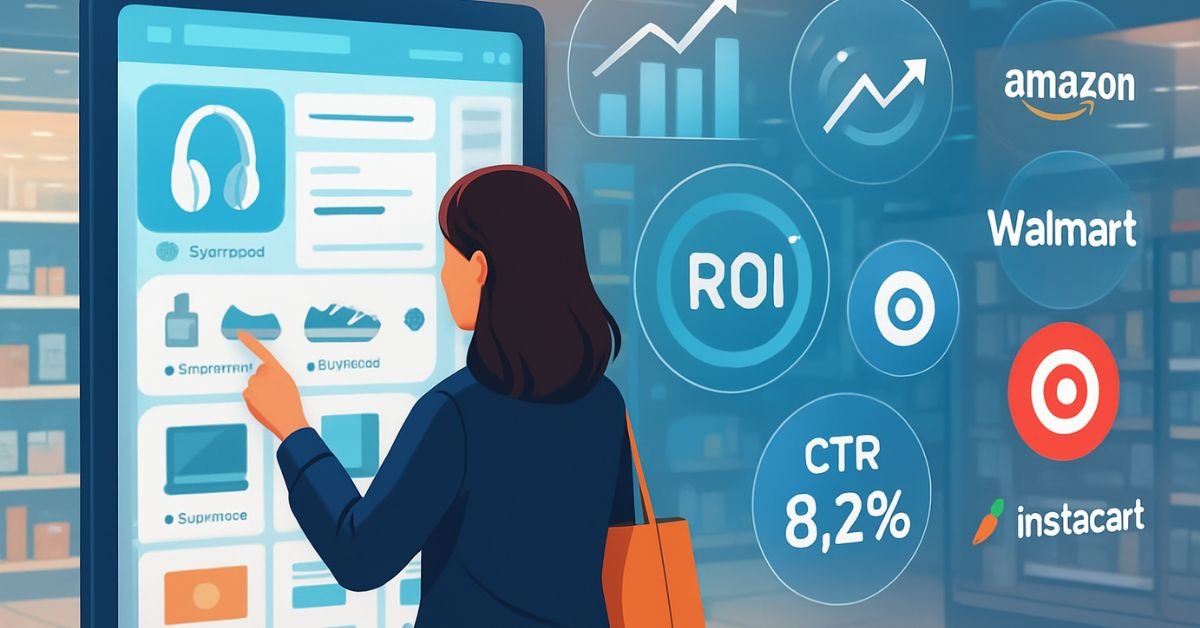Imagine entering a store where each item is customized to your preferences. That’s retail media in action, but it takes place on digital screens and online. For people who are new to it, retail media, which is just advertising on a store’s internet channels, may seem difficult. These ads let firms reach people when they are most inclined to buy something. A well-planned retail media strategy sales approach is a fantastic way to enhance sales and return on investment (ROI) in a world where every marketing dollar needs proof of impact.
This tutorial will educate you on the basics, provide you with a step-by-step approach for making your own retail media strategy, and use data-backed insights to help you make smarter choices.
Retail media blends in-store and online experiences, targeting shoppers with precision to boost sales and ROI

Retail media isn’t just about ads—it’s about connecting with the right customer, in the right place, at the right time
1. Knowing the Fundamentals of Retail Media Strategy Sales
You must understand the basics before beginning the steps.
What is retail media?
Placements of advertisements on a retailer’s websites, apps, or digital displays within their stores are referred to as retail media. Think of it as the store’s version of Facebook advertising, but with a greater focus on actual customers.
Why It’s Important for Novices:
- It targets customers who have already made a purchase.
- It makes use of retailer first-party data, which has grown in value as cookie tracking has decreased.
- It produces quantifiable outcomes that are closely linked to sales.
For instance, the first few items that appear when you search for “wireless headphones” on Amazon are sponsored products, advertisements in the retail media. This is a prime example of how a Retail Media Strategy Sales approach works in real time to capture buyers’ attention at the moment of purchase.
2. A Comprehensive Guide to Developing a Retail Media Strategy
Step 1: Establish Your Objectives for a Successful Retail Media Strategy Sales Plan
Prior to spending a single dollar, establish specific goals. Objectives might consist of:
- Boosting new product brand awareness.
- Increasing conversions in the course of seasonal marketing campaigns.
- To boost our return on investment (ROI), we are concentrating on buyers with high intent.
Pro Tip: Make use of the SMART framework, which stands for specific, measurable, achievable, relevant, and time-bound.
Step 2: Pick the Right Retail Media Networks
Not all platforms are compatible with every brand. As part of an effective Retail Media Strategy Sales plan, find out where the people in your target audience shop.
Popular networks include:
- Advertising on Amazon
- Walmart Connect
- Roundel Target
- Ads on Instacart
A marketplace like Amazon or Walmart might be perfect if you sell home appliances. A platform similar to Ulta’s retail media network might work better for beauty products.
Step 3: Divide Up Your Audience for an Effective Retail Media Strategy Sales Plan
Ads that directly address consumer needs are the most effective in retail media. Create segments using the retailer’s first-party data according to:
- Previous purchasing patterns.
- looking through the past.
- Where?
For example, a sportswear company may target customers who recently bought running shoes with ads for related athletic wear.
Step 4: Choose Proper Formats for Advertising
Different formats are needed for different goals:
- Sponsored Products: To raise awareness, they appear in search results.
- Sponsored Brands: Put your logo, tagline, and a few other items on display.
- Use display ads to reach those who use the retailer’s app and website.
If your main goal is to get people to buy something, sponsored products are frequently a better investment because they show up where people are already looking.
Step 5: Increase the Effectiveness of Budgets and bids.
Cost-per-click (CPC) bidding is widely used by retail media platforms. Begin modestly and adjust in response to performance information.
Spend more on product categories or high-performing keywords, it is advised.
Step 6: Track and Assess Outcomes
The secret to success in retail media is constant optimization. Pay attention to metrics like
- Click-through rate (CTR)
- Conversion rate (CVR)
- Return on ad spend, or ROI
Spend more money on sponsored products, for example, if their CTR is 5% and display ads’ are only 1%.
Note:For such guides, visit my AI Guides category
Step 7: Integrate Retail Media Strategy Sales with your overall marketing strategy.
Retail media shouldn’t operate independently. Place it in line with:
- Campaigns on social media.
- Marketing via email.
- Partnerships with influencers.
A well-coordinated strategy makes it more likely that people will convert by sending the same message across several touchpoints.
3. Insights Based on Data to Help You With Your Strategy
Retail media is growing at a rapid pace. The data suggests investing in it for the following reasons:
- Growth of the Market
- eMarketer initiatives By 2025, retail media ad spending in the US will reach $61 billion.
- Brands moving their budgets from traditional digital ads to platforms geared toward retail is the cause of this growth.
- Increased Potential Return on Investment:
McKinsey claims that because of accurate targeting and sales attribution, retail media can provide a return on investment that is two to three times higher than that of other digital channels.
Advantage of First-Party Data:
First-party retailer data gives brands an advantage in reaching the right audience without worrying about privacy issues as third-party cookies disappear.
Increase in Conversion:
Retail media advertisements can increase conversion rates for sponsored placement products by 14%, according to a Criteo study.
4. Practical Example: Applying the Retail Media Strategy Sales Protocols
Suppose you are an organic snack vendor.
- Goal: In three months, boost sales of your new gluten-free chips by 20%.
- Platform: Use Amazon Advertising because most of your customers shop on Amazon.
- Target audience: People who bought healthy snacks in the past six months.
- Ad Format: Products that are paid for to show up for high-intent search phrases like “gluten-free snacks” or “healthy chips.”
- Spend $500 on the most popular keywords for the first two weeks.
- Check ROAS, CTR, and CVR every week to keep an eye on them.
- Integration: Use your chips to share culinary ideas on Instagram to help get the word out about the campaign.
Conclusion and Key Takeaways:
Retail media offers a high-ROI, data-backed way to advertise to people who are ready to buy.
Choose platforms where your audience shops and start with specific objectives.
To effectively target, use retailer data.
Choose ad formats based on your goals.
Track outcomes and make necessary adjustments for improved performance.
Include retail media in your broader marketing plan.
The data is clear: retail media is expanding quickly and producing quantifiable outcomes. You can confidently create a strategy that increases sales and ROI by using the data and this methodical approach.
It’s your turn now; begin modestly, try new things, and use the knowledge gained to grow your business.
Last updated on August 8, 2025

Hi, I’m Amarender Akupathni — founder of Amrtech Insights and a tech enthusiast passionate about AI and innovation. With 10+ years in science and R&D, I simplify complex technologies to help others stay ahead in the digital era.



